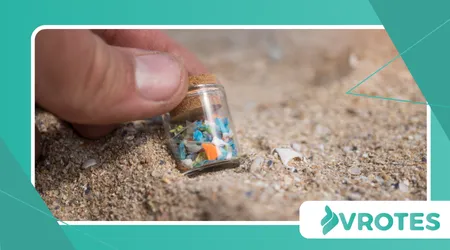Microplastics in the Food Chain: Hidden Nutritional Concerns

The pervasive issue of Microplastics in the Food Chain has escalated from an environmental blight to a critical public health dilemma.
Anúncios
As plastic fragments, smaller than 5 millimeters, permeate our ecosystems, they inevitably find their way onto our plates.
This column explores the subtle yet significant nutritional concerns arising from this silent infiltration.
The Silent Journey: From Ocean to Organism
Microplastics are virtually everywhere, from the deepest oceans to the air we breathe. Marine life, mistaking these tiny particles for food, absorbs them readily.
Consequently, these contaminants are incorporated into the tissues of fish and shellfish. This initial step sets the stage for transfer up the entire food web.
Anúncios
The journey continues as terrestrial animals ingest microplastics through contaminated water or feed.
Even seemingly pristine sources like sea salt and bottled water contain detectable levels. We are, essentially, living in a plastic-infused world.
More Than Just Inert Debris: Chemical Contaminatio
The danger is not merely the physical presence of the plastic itself, which can cause internal abrasion. Microplastics act like tiny toxic sponges in the environment.
They possess a high surface area, efficiently adsorbing pollutants like PCBs (polychlorinated biphenyls) and DDT.
When an organism consumes the plastic, these concentrated toxins can desorb—release—into the animal’s gut.
This process is a significant pathway for persistent organic pollutants to enter the food supply. These chemical hitchhikers pose a considerable threat to human health.
The Nutritional Shell Game: Bioavailability and Absorption
This chemical transfer introduces a complex challenge to nutrient absorption.
Some researchers hypothesize that microplastics and their associated chemicals may interfere with the uptake of essential vitamins and minerals.
The plastic particles could potentially hinder the function of the gut lining.
Imagine your digestive system as a highly specialized filter, and the microplastics as tiny, sticky residue clogging its mesh.
This blockage impairs the efficient passage of nutrients into the bloodstream. It’s an insidious form of nutritional sabotage.
Undermining Essential Nutrients: Focus on Seafood
Seafood, celebrated for its high content of Omega-3 fatty acids, faces a particular scrutiny.
The concern is that the benefit of these healthy fats could be compromised by the co-ingestion of microplastics and their pollutants.
Read more: The Role of Resistant Starch in Blood Sugar Control
For example, some studies suggest that chemical contaminants associated with microplastics are endocrine disruptors.
Disruption of the endocrine system can have far-reaching effects on metabolism and overall health. Consequently, the nutritional ledger of otherwise healthy foods shifts alarmingly.
This complex interplay of benefits and risks requires urgent attention from food safety regulators.

A Stark Reality: Evidence of Exposure Microplastics in the Food Chain
The sheer scale of microplastic contamination is staggering. A 2019 study published in the journal Environmental Science & Technology estimated that the average person consumes between 39,000 and 52,000 microplastic particles annually.
This alarming statistic underscores the universality of the problem.
See how interesting: Nutrient Timing: Best Times to Eat for Energy and Sleep Support
Furthermore, scientists have confirmed the presence of microplastics in human blood and even lung tissue.
This demonstrates that inhalation and ingestion routes are fully established, confirming systemic exposure. Microplastics in the Food Chain is clearly a direct human health issue.
Regulatory Gaps and the Path Forward
Current food safety regulations were not designed to account for this level of plastic contamination.
The existing framework is struggling to adapt to this novel and widespread contaminant. We urgently need global standards for monitoring and limiting plastic content in food.
Consumers must also wield their purchasing power to demand sustainable packaging and reduced plastic usage.
Every single choice, no matter how small, contributes to the solution. Can we, in good conscience, continue to ignore this pervasive contamination?
A Call for Change: Systemic Solutions
Addressing the issue requires a systemic overhaul, moving beyond individual consumer action.
Global industry must pivot towards truly biodegradable and compostable materials. Innovation in waste management and plastic breakdown technologies is essential.
For instance, consider a farming community near a river contaminated with plastic runoff. The vegetables irrigated with that water may absorb nanoplastics through their roots.
This hypothetical Microplastics in the Food Chain scenario highlights non-marine exposure.
++ How Reflexology Stimulates Parasympathetic Activation
Another original example: a major dairy producer discovers that trace microplastics are migrating from the plastic feed bags into the animal feed.
This then shows up in the resulting milk, illustrating an unexpected industrial vector for contamination. This is the reality we face.
Research and Mitigation: Securing the Food Future
Further research must focus on the specific ways microplastics interact with the human digestive and metabolic systems.
We need to quantify the true impact on nutrient absorption and bioavailability. Only then can effective public health advisories be developed.
It is a vital step toward securing the nutritional integrity of our food supply.
The health of Microplastics in the Food Chain ultimately reflects the health of our planet. We must act decisively.
| Potential Nutritional Impact of Microplastics | Mechanism of Action |
| Reduced Nutrient Bioavailability | Physical blockage or irritation of the intestinal wall, hindering absorption of vitamins and minerals. |
| Toxic Chemical Exposure | Release (desorption) of adsorbed Persistent Organic Pollutants (POPs) into the gut, leading to systemic toxicity. |
| Endocrine Disruption | Associated chemicals, like phthalates, mimicking or blocking hormones, affecting metabolic functions. |
| Gut Microbiome Alteration | Possible disruption of the balance of beneficial gut bacteria due to chronic foreign particle exposure. |
This table outlines key areas of concern regarding Microplastics in the Food Chain.

Microplastics in the Food Chain
The challenge of microplastics in our food is complex, intertwining environmental, chemical, and nutritional concerns.
It is a hidden tax on our health, silently eroding the nutritional value of our food. Addressing it demands global collaboration, sustained innovation, and transparent communication.
We must prioritize a future free from plastic pollution.
We need to collectively recognize that environmental contamination is not merely an external problem; it is an intimate part of our diet and well-being.
The fight against plastic is a fight for our right to truly clean nutrition.
Frequently Asked Questions
What are microplastics, and how do they enter our food?
Microplastics are plastic fragments less than 5 millimeters in length.
They enter the food supply through various routes: marine animals ingest them in polluted waters; terrestrial animals consume them via contaminated feed or water; and even produce can be exposed through irrigation with tainted water.
Can cooking or filtering remove microplastics from food?
While some studies suggest certain water filtration systems can reduce microplastic counts, it’s virtually impossible to remove them entirely from solid foods like seafood or salt.
Their minute size makes conventional methods ineffective.
Are there any specific foods that are higher in microplastics?
Shellfish (like mussels and oysters) and certain types of fish often show higher levels because they consume particles directly from polluted water.
Additionally, products like sea salt and bottled water frequently contain detectable microplastic particles.
What can I do as a consumer to reduce my exposure?
Reducing your overall plastic consumption is the best defense.
Choose unpackaged goods, use reusable containers, and support companies committed to reducing plastic waste. Also, consider the source of your seafood and water.
Is the scientific community actively researching the health effects?
Yes, there is a rapidly growing body of research dedicated to understanding the toxicology of microplastics and their associated chemicals.
Studies focus on their impact on the gut, immune system, and overall metabolic health.
